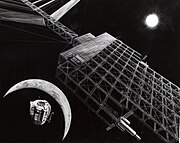Teknologi tenaga surya terus mengalami kemajuan, mulai dari panel surya sederhana sampai panel yang lebih efisien. Tetapi para ilmuwan NASA percaya langkah memaksimalkan energi berbasis matahari berikutnya akan tercapai melalui satelit permanen tenaga surya.
Idenya adalah menggunakan satelit dengan susunan cermin untuk mengumpulkan energi Matahari. Energi yang terkumpul akan dikirim kembali ke bumi dalam bentuk pancaran microwave.
A solar power satellite, or SPS or Powersat, as originally proposed would be a satellite built in high Earth orbit that uses microwave power transmission to beam solar power to a very large antenna on Earth. Advantages of placing the solar collectors in space include the unobstructed view of the Sun, unaffected by the day/night cycle, weather, or seasons.
It is a renewable energy source, zero emission after putting the solar cells in orbit, and only generates waste as a product of manufacture and maintenance. However, the costs of construction are very high, and SPS will not be able to compete with conventional sources (at current energy prices) unless at least one of the following conditions is met:
- Sufficiently low launch costs can be achieved
- A determination (by governments, industry, ...) is made that the disadvantages of fossil fuel use are so large they must be substantially replaced.
- Conventional energy costs increase sufficiently to provoke serious search for alternative energy
In common with other types of renewable energy such a system could have advantages to the world in terms of energy security via reduction in levels of conflict, military spending, loss of life, and avoiding future conflict over dwindling energy sources.
Sejarah
Sejarah
The SPS concept was first described in November 1968. In 1973 Peter Glaser was granted U.S. patent number 3,781,647 for his method of transmitting power over long distances (eg, from an SPS to the Earth's surface) using microwaves from a very large (up to one square kilometer) antenna on the satellite to a much larger one on the ground, now known as a rectenna.
Glaser then worked at Arthur D. Little, Inc., as a vice-president. NASA signed a contract with ADL to lead four other companies in a broader study in 1974. They found that, while the concept had several major problems -- chiefly the expense of putting the required materials in orbit and the lack of experience on projects of this scale in space, it showed enough promise to merit further investigation and research.
During the period from 1978 - 1981 the US Congress authorized DOE and NASA to jointly investigate. They organized the Satellite Power System Concept Development and Evaluation Program. The study remains the most extensive performed to date. Several reports were published investigating possible problems with such an engineering project. They include:
- Resource Requirements (Critical Materials, Energy, and Land)
- Financial/Management Scenarios
- Public Acceptance
- State and Local Regulations as Applied to Satellite Power System Microwave Receiving Antenna Facilities
- Student Participation
- Potential of Laser for SPS Power Transmission
- International Agreements
- Centralization/Decentralization
- Mapping of Exclusion Areas For Rectenna Sites
- Economic and Demographic Issues Related to Deployment
- Some Questions and Answers
- Meteorological Effects on Laser Beam Propagation and Direct Solar Pumped Lasers
- Public Outreach Experiment
- Power Transmission and Reception Technical Summary and Assessment
- Space Transportation
The Office of Technology Assessment concluded
Too little is currently known about the technical, economic, and environmental aspects of SPS to make a sound decision whether to proceed with its development and deployment. In addition, without further research an SPS demonstration or systems-engineering verification program would be a high-risk venture.
More recently, the SPS concept has again become interesting, due to increased energy demand, increased energy costs, and emission implications, starting in 1997 with the NASA "Fresh Look". In assessing "What has changed" since the DOE study, this study asserts that
Another important change has occurred at the US national policy level. US National Space Policy now calls for NASA to make significant investments in technology (not a particular vehicle) to drive the costs of ETO [Earth to Orbit] transportation down dramatically. This is, of course, an absolute requirement of space solar power.
A 2004 NASA report presents three possible SPS designs and argues for designing an SPS for peak electricity prices instead of baseline prices.
A 2007 Fox news report states that "The Pentagon's National Security Space Office (NSSO) may begin a study in the near future on the possibility of using satellites to collect solar energy for use on Earth" but that "the study does not mean that the military plans to demonstrate or deploy a space-based solar power constellation."
Lihat Juga:
- Centennial Challenges NASA prize contests
- Exploration of Mars
- Human spaceflight
- Space exploration
- Space colonization
- Timeline of artificial satellites and space probes
Link Luar
- Race2Space.org - Advancing the Privatization of Space Travel 2006, Race2Space, in partnership with the X Prize foundation, is seeking sponsorship in order to support the privatization of space travel, research, and exploration for the upcoming Lunar Landing Challenge Contestants October 2006."
Categories: Space technology
Referensi-referensi:
Referensi-referensi:
- ^ Staff (July 18, 2007). "Columbus laboratory". ESA. Retrieved on 2007-07-18.
- Andrew H. Cutler, Metallurgical Properties of Lunar and Asteroidal Steels, 7th Princeton/AIAA/SSI Conference, 1985.
- David Gump, Space Enterprise: Beyond NASA, Praeger Publishers, 1990, ISBN 0-275-93314-8.
- T. A. Heppenheimer, Colonies in Space, 1977, Stackpole Books, ISBN 0-8117-0397-5.
- Lewis, J., Matthews, M.S., and Guerrieri, M.L., Editors, 1993, Resources of Near-Earth Space, University of Arizona Press, 1993. ISBN 978-0816514045.



























No comments:
Post a Comment